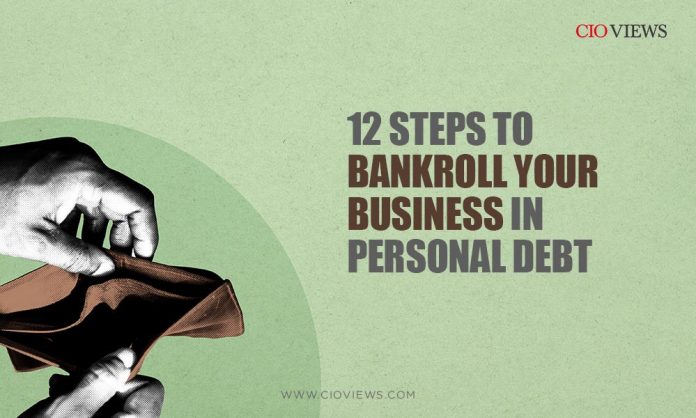Starting and sustaining a successful business often requires a strategic approach to financing. While there are various funding options available, personal debt can be a viable solution to bankroll your business effectively. A clear picture of your standing will help you make informed decisions and set realistic goals for bankroll your business.
In this guide, we’ll explore the essential steps you need to take to ensure a smooth and successful journey in leveraging personal debt for your business.
-
Assessing Financial Needs
Before diving into personal debt, it’s crucial to understand the financial requirements of your business. Conduct a comprehensive assessment of your budget, considering both immediate and long-term needs. This step sets the foundation for a successful bankrolling strategy.
-
Personal Budgeting
Creating a personal budget is the cornerstone of effective financial management. Allocate funds from your personal finances to support your business goals. A well-structured budget ensures that you can cover both personal and business expenses without compromising either.
-
Exploring Loan Options
The market offers various loan options tailored to business needs. From traditional bank loans to alternative lending sources, explore the options available and choose the one that aligns with your business requirements. Assess interest rates, repayment terms, and overall feasibility.
-
Managing Credit Score
A good credit score is instrumental in securing favorable loan terms. Monitor your credit score regularly and take proactive steps to improve or maintain it. A healthy credit score not only aids in obtaining loans but also reflects positively on your financial credibility.
-
Creating a Business Plan
Crafting a detailed business plan is essential for attracting investors and lenders. Clearly outline your business goals, target market, and financial projections. A well-presented business plan increases your chances of securing financial support.
-
Seeking Investor Partnerships
Building partnerships with investors can inject capital into your business while also providing valuable expertise. Present your business idea convincingly and demonstrate the potential for mutual success. Strong investor relationships can be a game-changer in your bankrolling strategy.
-
Crowdfunding Strategies
Crowdfunding has emerged as a popular means of raising funds. Leverage platforms like Kickstarter or Indiegogo to reach a broader audience. Implement effective marketing strategies and clearly communicate the unique value proposition of your business to attract backers.
-
Exploring Government Grants
Many governments offer grants to support small businesses. Research available grants in your region, understand the eligibility criteria, and follow the application process diligently. Government grants can provide a significant financial boost without incurring debt.
-
Negotiating Vendor Financing
Establishing favorable financing terms with vendors can ease the financial burden on your business. Negotiate payment terms that align with your cash flow, fostering a positive relationship with suppliers.
-
Savings and Emergency Funds
Set aside a portion of your income for savings and emergency funds. Having a financial safety net allows you to navigate unforeseen challenges without relying solely on debt. A robust emergency fund is a prudent measure for long-term business sustainability.
-
Monitoring and Adjusting
Regularly monitor your business’s financial health and be prepared to make adjustments to your bankrolling strategy as needed. Adaptability is key to navigating the dynamic business landscape and ensuring continued success.
Read: Racquel Oden: Expanding Financial Health & Inclusion to Those Who Need It Most
-
Avoiding Common Pitfalls
Learn from the experiences of others by identifying and avoiding common pitfalls in personal debt bankrolling. Understanding potential challenges allows you to make informed decisions, steering clear of unnecessary risks.
Success Stories
Based guidance from successful entrepreneurs who used personal debt can yield valuable insights. Real-life success stories demonstrate the viability and potential benefits of strategic financing. Learn from those who have taken similar steps to build successful businesses.
Conclusion
Finally, using personal debt to fund your business requires careful planning and execution. By taking these 12 steps, you can navigate the complexities of leveraging personal debt while minimizing risks. Remember that every business journey is unique, and modifying these steps to your specific needs will pave the way for financial success.
FAQ’s
- Is personal debt a risky option for bankrolling a business?
– While it comes with risks, personal debt can be a viable and strategic option when approached wisely. It’s essential to assess your financial situation and have a clear repayment plan in place.
2. How can I improve my credit score for better loan terms?
– Focus on timely bill payments, reducing credit card balances, and monitoring your credit report for inaccuracies. These steps can positively impact your credit score over time.
3. Are government grants accessible to all businesses?
– Government grants often have specific eligibility criteria. Research thoroughly, ensuring your business aligns with the grant’s objectives and requirements.
4. What should I include in my business plan for effective bankrolling?
– Your business plan should cover your business goals, target market





